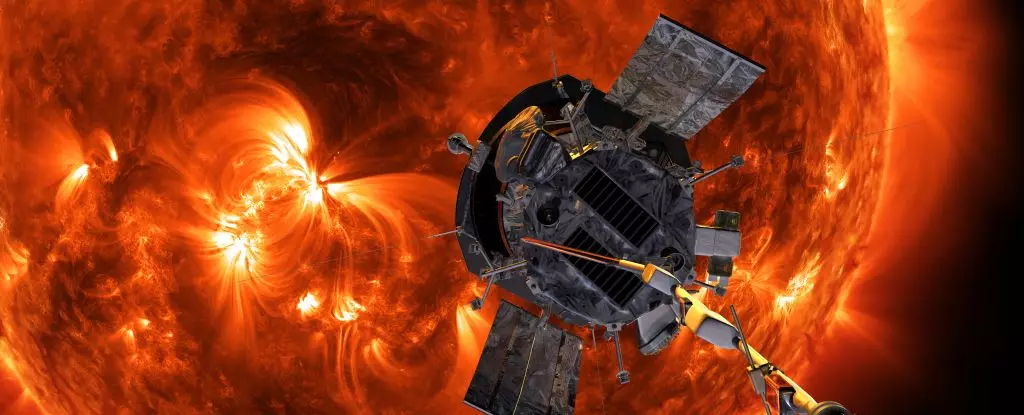The Parker Solar Probe is set to make groundbreaking achievements that will mark a new chapter in the exploration of our solar system. On Christmas Eve 2023, the spacecraft will approach the Sun closer than any man-made object in history, executing a daring flyby at an astonishing speed of approximately 192 kilometers per second (about 427,000 miles per hour). In doing so, it will skim just 6.1 million kilometers (3.8 million miles) from the Sun’s surface—a feat that has garnered immense anticipation from scientists and space enthusiasts alike. This 22nd close encounter reveals not only the effectiveness of NASA’s ambitious mission but also the endless curiosity of humanity as we strive to understand the very essence of the star that sustains our planet.
Launched in August 2018, the Parker Solar Probe was designed to unravel some of the most enigmatic questions surrounding our Sun. While we have collected diverse data on our closest star, important mysteries remain. For instance, the solar corona—the outer layer of the Sun—has been inexplicably found to be hundreds of times hotter than the surface of the Sun itself. This phenomenon has puzzled scientists for decades, and the Parker Solar Probe aims to provide insights that could potentially illuminate this and other solar mysteries.
Furthermore, understanding the Sun’s magnetic field generation and the drivers behind its solar cycles are central to advancing our knowledge of solar physics. By studying the solar corona up close, the Parker Solar Probe will provide invaluable data that directly contribute to these inquiries. The challenge of gathering this information while barreling toward the Sun at unprecedented velocities adds to the thrill of this mission. As noted by leading astronomer Arik Posner, the Parker Solar Probe is emblematic of our determination to break barriers that have limited our understanding of the universe.
Every new milestone achieved by the Parker Solar Probe serves as a demonstration of human ingenuity. The spacecraft is not merely a scientific instrument; it embodies humanity’s relentless pursuit of knowledge. Astrophysicist Nour Raouafi expressed the magnitude of this mission by comparing its potential impact to the historic moon landing of 1969, asserting that we are “basically almost landing on a star.” As we prepare for the critical perihelion on December 24, 2023, the excitement builds for the post-flyby data transmissions that will confirm the probe’s status and begin unlocking the secrets of solar science.
But there is a profound aspect of exploration reflected in this journey—a meditative reminder of fragility in the face of cosmic forces. The Parker Solar Probe exists as a testament that pushing boundaries involves risk. Upon completing a successful flyby, the probe will send a beacon tone on December 27 to affirm its continued operation, transforming speculation and uncertainty into monumental achievement.
In a world rich with science fiction and imagined futures, Parker’s mission resonates with the idea that venturing into uncharted territory is essential for progress. Scheduled for additional perihelions in 2025, the probe will maintain its trajectory at comparable speeds and distances from the Sun, revealing more information about our star’s behavior and properties. However, a harsh reality looms: eventually, the probe will exhaust its fuel, leaving it vulnerable to the very forces it seeks to study. According to astrophysicist Justin Kasper, as the probe loses the ability to adjust its trajectory, its fate could lead to a fiery end as it succumbs to the solar wind.
Yet, even the eventual demise of Parker will not signify complete loss. Should a fiery conclusion await, it will merely cement the mission’s legacy—a legacy marked by bold exploration and significant scientific breakthroughs that extend into the core of solar dynamics. The carbon heat shield and some critical components may endure, leaving behind remnants of human endeavor to orbit the Sun for millennia.
The story of the Parker Solar Probe showcases humanity’s unyielding quest to understand the cosmos. Each flyby, each piece of data returned to Earth contributes to a larger narrative—a narrative of discovery, curiosity, and the indomitable spirit of exploration. As we await the next transmissions and the procedure of scientific analysis that will follow, we cannot help but marvel at the notion that we are boldly confronting the mysteries of the universe. Indeed, in the words of aerospace engineer Nick Pinkine, Parker will not only return data from uncharted territory but will serve as a beacon of hope for future explorers venturing into the great unknown.

